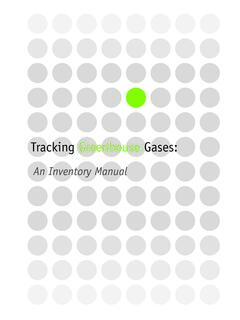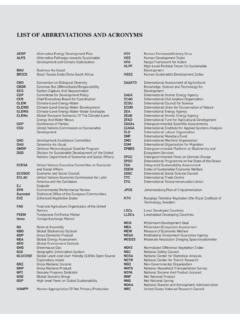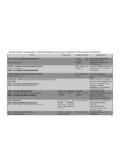Transcription of 2011-2028
1 2011-2028 . FOREWORD. The manifestations of climate change in the form of rising temperature, variability of precipitation, frequency and intensity of typhoons, sea level rise, and the risks of more droughts, floods, heat waves, and forest and grassland fires have impacts on the economy, environment and communities. Given its geographical location, archipelagic formation in the tropical pacific , and population distribution, the Philippines is greatly vulnerable to the impacts of climate change, and has already experienced noticeable adverse effects in recent years. Without concerted global and local action, the challenges the country will face as a result of climate change are expected to intensify in the medium or long term.
2 In response to what has essentially become a global crisis, the government has enacted the Climate Change Act (Republic Act 9729) that provides the policy framework with which to systematically address the growing threats on community life and its impact on the environment. The Climate Change Act establishes an organizational structure, the Climate Change commission , and allocates budgetary resources for its important functions. These functions include: the formulation of a framework strategy and program, in consultation with the global effort to manage climate change, the mainstreaming of climate risk reduction into national, sector and local development plans and programs, the recommendation of policies and key development investments in climate-sensitive sectors, the assessments of vulnerability and facilitation of capacity building.
3 The national climate change framework strategy has recently been translated into a National Climate Change Action Plan (NCCAP), which prioritizes food security, water sufficiency, ecological and environmental stability, human security, climate-smart industries and services, sustainable energy, and knowledge and capacity development as the strategic direction for 2011 to 2028. This document assesses the current situation of the country with regard to climate change risk and outlines the NCCAP's strategic direction for 2011 to 2028 as a response to the current situation and projected impact. i Contents i Foreword iii List of Tables iii List of Figures iv Acronyms and Abbreviations 2 Introduction 3 Legal Mandate 4 The Framework 5 The Action Plan 7 I.
4 Food Security 11 II Water Sufficiency 14 III. Ecological and Environmental Stability 16 IV. Human Security 19 V. Climate-Smart Industries and Services 23 VI. Sustainable Energy 33 VII. Knowledge and Capacity Development 36 VIII. Cross-cutting Actions 42 IX. Means of Implementation 48 X. Monitoring and Evaluation 49 Bibliography 51 NCCAP Acknowledgement 61 Annex A Outcomes, Outputs and Activities for 2011-2028 . The National Climate Change Action Plan: Goals and Outcomes 1 Food Security 2 Water Sufficiency 3 Ecological and Environmental Stability 4 Human Security 5 Climate-smart Industries and Services 6 Sustainable Energy 7 Knowledge and Capacity Development ii List of Tables Table 1 25.
5 Total GHG Emission (GGCO2E), 2000. Table 2 27. Estimated potential total CO2 emission reduction from 10% energy savings from all sectors Table 3 29. Renewable energy expansion under the Climate Change strategy of the Department of Energy Table 4 30. Competitiveness of renewable energy (As of May 2007). Table 5 31. Biodiesel blend targets and potential savings Table 6 45. National government budget allocations for direct and indirect climate change adaptation and mitigation, in USD. List of Figures Figure 1 7. Estimated cost of natural disasters to agriculture, 1990-2006. Figure 2 8. Estimated Agricultural Damages from worst typhoons within the months of July to December, 1980-2010.
6 Figure 3 9. Strategic Actions on Food Security for 2011-2028 . Figure 4 13. Strategic Actions on Water Sufficiency Actions for 2011-2028 . Figure 5 15. Strategic Actions on Ecological and Environmental Stability for 2011-2028 . Figure 6 17. Conceptual Linkages of Climate Change adaptation and Disaster Risk management iii Figure 7 18. Strategic actions on Human Security for 2011 to 2028. Figure 8 21. Strategic Actions on Climate-smart industries and services for 2011-2028 . Figure 9 23. Total Primary Energy Supply (MTOE), 2009. Figure 10 24. Self-sufficiency and Fuel Diversification in Power Figure 11 25. Energy Sector Greenhouse Gas Emission (MtCO2e), 1999-2009. Figure 12 26.
7 Strategic Actions on Sustainable Energy for 2011-2028 . Figure 13 35. Strategic actions on Knowledge and Capacity Development for 2011 to 2028. Figure 14 40. Funding gap in technology development (Maclean, et al. 2008). Figure 15 43. Ecotown framework Figure 16 45. Comparative Flows of Total Direct Grants & Loans by Major Measure, by Funding Category, 1992-2018 (In US $). Acronyms & Abbreviations AMORE Alliance for Mindanao Off-grid Renewable Energy CASS Climate Adaptation Support Service CC Climate Change CCA Climate Change Adaptation CCC Climate Change commission CCVI Climate Change Vulnerability Index CEPALCO Cagayan Electric Power and Light Company, Inc. CFI Commercial Financial Institutions CHED commission on Higher Education CRM Climate Risk Management iv DA Department of Agriculture DAR Department of Agrarian Reform DENR Department of Environment and Natural Resources DepED Department of Education DFI Development Finance Institutions DILG Department of Interior and Local Government DOE Department of Energy DOF Department of Finance DOH Department of Health DOLE Department of Labor and Employment DOST Department of Science and Technology DPWH Department of Public Works and Highways DRR Disaster Risk Reduction DRRM Disaster Risk Reduction and Management DSM Demand Side Management DSWD Department of Social
8 Welfare and Development DTI Department of Trade and Industry ECHA European Chemicals Agency Ecotown Ecologically-Resillient and Economically Sustainable Town EDC Energy Development Corporation ENRA Environmental and Natural Resource Accounting EST Environmentally Sound Technologies GDP Gross Domestic Product GHG Greenhouse gases HUDCC Housing and Urban Development Coordinating Council HVAC Heating, Ventilation and Air-Conditioning IEC Information and Education Campaign IFC International Finance Corporation IUCN International Union for Conservation of Nature IWRM Integrated Water Resources Management IPCC Intergovernmental Panel on Climate Change KBA Key Biodiversity Area KtOe Kilo ton of Oil equivalent LDCs Least Developed Countries LG Local Government LGU Local Government Unit LUCF Land Use Change and forestry LWUA Local Water Utilities Administration MDFO Municipal Development Finance Office MDGF Millenium Development Goal Achievement Fund v MBFOE Millions Barrels of Fuel Oil Equivalent MW Megawatt NCCAP National Climate Change Action Plan NCIP
9 National commission on Indigenous People NDRRMC National Disaster Risk Reduction and Management Council NEDA National Economic and Development Authority NEDO New Energy and Industrial Technology Development Organization NFSCC National Framework Strategy on Climate Change NG National Government NGO Non-Government Organization NREL National Renewable Energy Laboratory NRPS National REDD Plus Strategy NWRB National Water Resources Board P3W President's Priority Program on Water PA Protected Area PAGASA Philippine Atmospheric, Geophysical and Astronomical Services Administration PBE Philippine Business for the Environment PES Payments for Environmental Services PFM Public Finance Mechanism PIA Philippine Information Agency PNOC Philippine National Oil Company PPP Public-Private Partnership R&D Research and Development RA Republic Act RE Renewable Energy SHS Solar Home Systems SIDS Small Island Developing States SME Small and Medium Enterprise TESDA Technical Education and Skills Development Authority TPES Total Primary Energy Supply UNCRD United Nations Centre for Regional Development UNDP United Nations Development Program UNEP United Nations Environmental Programme UNESCAP
10 United Nations Economic and Social commission for asia and the pacific UNFCCC United Nations Framework Convention on Climate Change UNIDO United Nations Industrial Development Organization USAID United States Agency for International Development vi National Climate Change Action Plan 2011-2028 . 1. Introduction The global and local climate is changing. Current These scenarios thus indicate that the Philippines will climate trends show that the Philippines, like the rest not be spared from the impacts of climate change. Even of the world, has exhibited increasing temperatures, if the world will drastically decrease its greenhouse with observed mean temperature increase of C emissions, stabilizing the greenhouse gases already in or an average of C per year-increase from 1951- the atmosphere will take some time and the impacts 2010.










